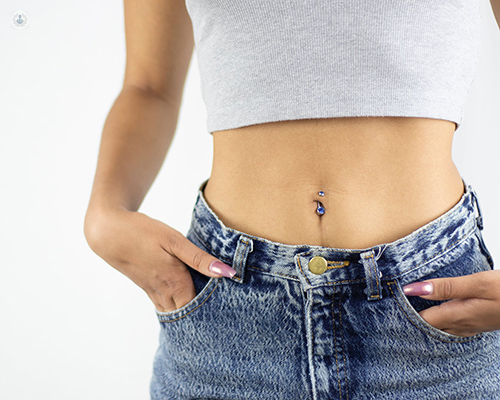The Brazilian tummy tuck explained
Written by:A Brazilian tummy tuck is an operation that improves the shape of the abdomen. It’s a popular procedure if you have worked hard to lose weight but there’s only so far that diet and exercise can take you in getting rid of that last bit of excess skin. Maybe you have reached your goal weight but not your desired shape.
Here, expert plastic surgeon Mr Ian Grant explains everything about the procedure, which is now becoming a more common way to remove stubborn pockets of belly fat.

What happens during a Brazilian tummy tuck?
A Brazilian tummy tuck uses a combination of:
- abdominoplasty plastic surgery to remove excess skin
- extensive liposuction to remove abdominal wall fat
- tightening of the deep layer of thicker tissue to tighten the waste
- approximation (closing together) of the abdominal wall muscles to reduce any bulge
These combined measures can produce good results in patients with excess or loose fat and skin.
The use of liposuction reduces the amount of tissue that has to be lifted from the abdominal wall during the procedure and can reduce the extent of the surgery. It can potentially avoid the need to use drains after surgery, which are almost always required with other forms of abdominoplasty. The tightening of the deep layer of thicker tissue (which is called Scarpa’s fascia) can produce tightening of a patient’s waist after surgery.
The scar from the surgery is similar to other forms of abdominoplasty: it can usually be hidden below the beltline and around the belly button. In some patients, the release of skin and removal of fat using liposuction can help reduce the length of the scar.
Why should you choose one over a traditional abdominoplasty?
A Brazilian Tummy tuck is probably best suited to women with loose skin and fat. In these patients, the combination of liposuction and tightening of the tissue below the skin of the abdomen is likely to get a better shape with a tighter waistline. With appropriate preparation, a Brazilian tummy tuck can be carried out at the same time as another operation, such as removal of excess tissue from the upper arms (Brachioplasty).
A Brazilian tummy tuck is not suited to patients who are obese as each patient is unique, but generally, patients should achieve a weight that is within 20% of the upper limit of an ideal body mass index (BMI). I would not recommend abdominoplasty surgery in any woman considering having more children.


What happens after the procedure?
The pain after surgery is usually well-controlled. Before the start of the operation and after the administration of a general anaesthetic, an ultrasound scanning machine is used to help administer local anaesthetic into the edges of the abdominal wall.
I will also inject local anaesthetic around the muscles during surgery. These two interventions provide very good pain relief for the first day after surgery.
Patients usually stay in the hospital for at least one night. If no drains are used the patient is usually able to walk unaided on the first evening after surgery. If drains are required, these are usually removed on the next day after surgery.
Is there a recovery period?
The recovery time is similar to any other form of abdominoplasty surgery. Patients can usually shower and drive independently at about 10 days. I suggest that patients take two weeks away from clerical or managerial work.
I ask patients to wear a compression garment around the abdomen for about six weeks. I am happy for patients to return to gentle exercise at about three weeks, but ask the patient to avoid strenuous exercise and competitive sport for at least six weeks.
Recovery after surgery can vary from one individual to another and can be prolonged if a patient experiences a complication or problem.
How long do results last?
The changes achieved with surgery are likely to be transformative and last a lifetime. The appearance of the abdomen will, however, change with age as the skin will lose some of its tightness and elasticity over a period of years. If a patient maintains a healthy weight and incorporates regular exercise into her week, it is likely that she will be pleased with the tummy tuck for the rest of her life.
Considering a Brazilian tummy tuck? Do not hesitate to book an appointment for a first consultation with Mr Grant today!


